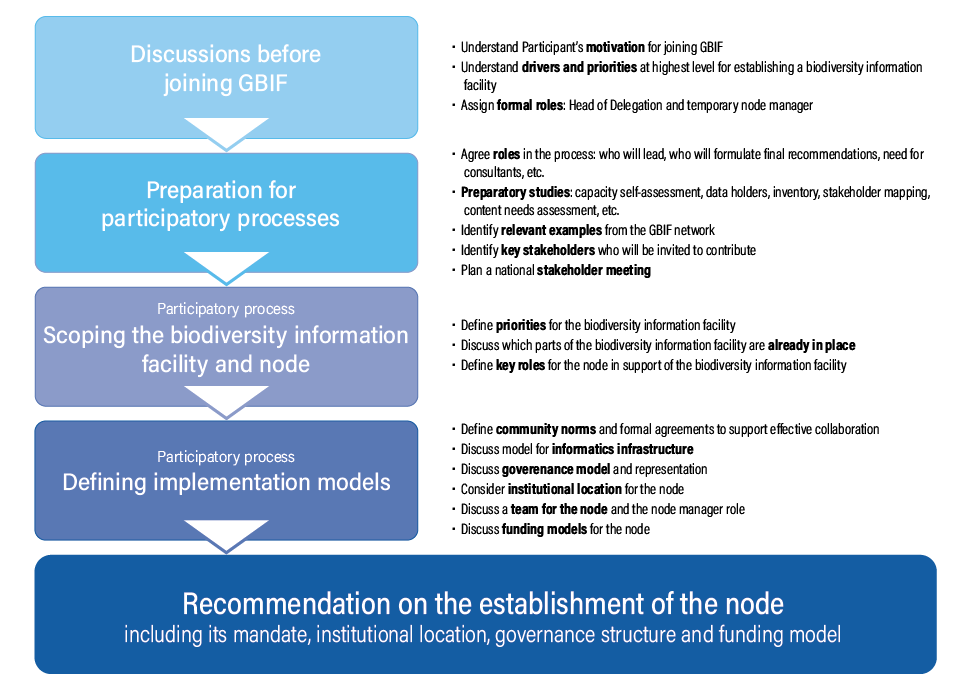Participatory approach
Establishing a node is one of the commitments that Participants make when joining GBIF. We recommend that Participants start planning for their node as early as possible in the process of joining GBIF.
Nodes play an essential role in helping to coordinate activities relating to GBIF within the country or organization’s scope and in linking these to the global network. Having an effective node is essential to ensuring that the Participant benefits fully from their membership in GBIF.
|
Read the sections on what nodes need to be effective and on the recommended process for establishing a Participant node in the nodes guidance document. 
Participatory approach to establishing a node
GBIF recommends taking a participatory approach to establishing a node, in order to build collaboration among the key stakeholders and establish a clear mandate for the node from the start. The decision on where to situate a node within the landscape of stakeholder institutions will impact the node’s focus and priorities. The potential advantages and disadvantages of the typical hosting institutions are discussed in the nodes guidance document. In an ideal scenario, nodes will have access to a strong team and appropriate budget to enable them to carry out all the services that nodes provide that we looked at in an earlier section. Often, however, nodes start with a small team and limited resources. In order to be most effective, nodes should consider which roles are essential for them to carry out, and which can be delegated to other stakeholders in the network they will be establishing. A good way to formalize these collaborations and shared roles is to establish governance structures, such as a board or steering committee, as well as advisory committees, such as a scientific advisory committee. |
|
Read a guiding example from the node in Chile, in which they discuss the establishment of their node through a process involving needs assessment and community consultation. |
Scoping a node - Exercise 3
In this final exercise, we will return to the context set out in the use case for the fictitious country of Darwinia and assume that you were successful in gaining the attention of the Ministry with your pitch in Exercise 2. You will now be tasked to scope out a recommendation for the establishment of a Darwinia node.
| There are multiple valid ways to approach this exercise - we are not expecting a single 'right' solution here. Focus on explaining the node model that you choose and why you think it would be a good model for Darwinia. When providing your rationale, you can refer to details provided in the use case and you should feel free to imagine other details to strengthen your explanations. |
|
In your your exercise 3 sheet (available on the Files for download page), referring to the use case scenario, develop a recommendation for the establishment of a new Participant node in Darwinia. |
Step 1: Imagine that you have been appointed to oversee a national stakeholder workshop to develop a recommendation for the establishment of a node in Darwinia. During this meeting, you discuss the priorites for the new node and agree that they are:
-
Training and supporting institutions that hold and produce biodiversity data in data management and data publishing via GBIF to increase the data availability for Darwinia.
-
Establishing a community of practice among potential users of GBIF-mediated data to increase the use of data in research and policy.
-
Establishing a GBIF hosted portal to provide information on the node activities and access to the data available about biodiversity in the country.
-
Developing a strategy for data mobilization in the country, based on analysis of current data availability and user needs.
Consider which institution from Darwinia you would recommend to be the host for the node. Identify three likely advantages and three possible disadvantages of this host institution compared to other potential node host institutions. Relate this decision back to the priorities for the node.
Step 2: Describe a governance structure for this new node, including a board and advisory committee(s):
-
Which institutions would participate in the governance?
-
How will the governance structure provide guidance and oversight of the work of the node?
-
What benefits would this governance model bring to the Node?
Step 3: Describe a staffing model for the new node.
-
What type of skills/what sort of profile would you be looking for in someone who could take on each role?
-
Which tasks would each staff member be responsible for?
-
If you can only have two staff members, which roles would you prioritize?
Step 4: Send this to your peers for review. When reviewing, compare the answers to your own and provide feedback on any missing perspectives.
|
While working on this activity, we encourage you to consider how this would apply to your national context and keep track of any items you wish to discuss during the first group call. |